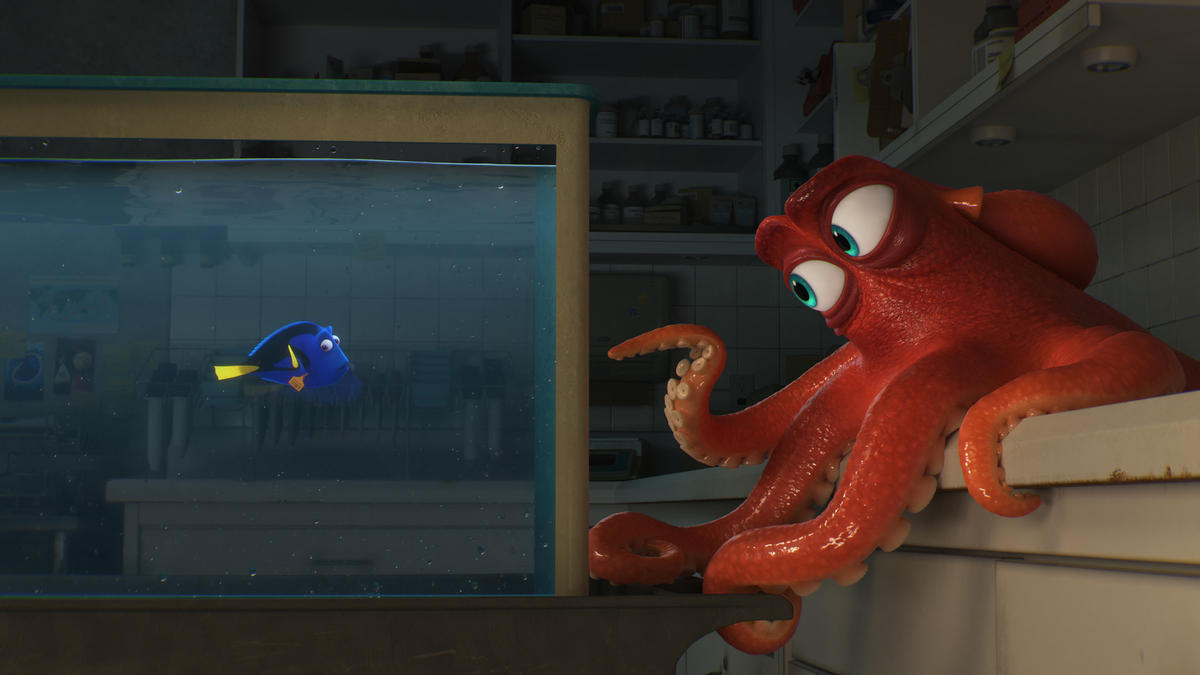Interview: Co-Director Angus MacLane on “Finding Dory”
Posted on November 14, 2016 at 8:00 am
Angus MacLane is co-director of the adorable “Finding Dory,” the sequel to “Finding Nemo.” In an interview, he spoke about the changes in technology and the decision to shift the focus to the memory-impaired fish voiced by Ellen DeGeneres. The DVD/Blu-Ray is available November 15, 2016.
How has the technology changed since finding Nemo and how did that affect your story, the setting and the characters?
That’s a good question. I think that thirteen years from release to release is such a huge time technologically. And so there was a brand-new animation system, there were brand-new articulation tools for the characters, there were brand-new lighting tools that were entirely different. So basically the system from the ground up was different. I think that one of the things that was a challenge in the first film was that water was so difficult to do and very complex, so it was difficult. It is still difficult but the effects we could get were so much more satisfying technologically that what we wanted to do was not the challenge that it was in the first film.
And so it just afforded us the chance to not worry about how these characters could break the surface of the water, which would have been a challenge in the first film, or where we were going to really spend our dollars doing splashes or big effects. They weren’t insignificant but it wasn’t a major hurdle in the same way where we would have to carefully plan for each of those effects that would potentially affect our story thirteen years ago. The technology improves and the renders in the computer speed improve and we’re always asking the computers and everyone to do things that are infinitely harder to keep pace with the speed and the technology. So it wasn’t any faster necessarily but we did have a lot of new technologies and a very capable crew to implement them and try out a bunch of new and interesting things.
Most sequels continue the story of the main character but this one makes Nemo and Marlin secondary to Dory. What went into that decision?
Well I think that the reason to do this film for Andrew Stanton really rested in seeing “Finding Nemo” in 3D several years ago, long after its release. He was worried about Dory. And so the question about where she had come from and if she was going to be okay became the reason for him to make the movie, the question that he most wanted to answer. So the idea was after this film the audience members would not be concerned for Dory and feel confident that if she got lost she could find your way back again.
This film has at least five characters with disabilities including Nemo, Dory and Hank. What was most important to you portraying the way that these characters adapt to and think about these disabilities?
I think the thing that was most important to us was that we showed them as four dimensional characters. Everyone in the film is at kind of a different stage than Dory is about their disability. Dory over the course of the film — not to spoil it for those people that haven’t seen it — but she learns to fully accept and embrace her disability and work it in a way that she did not at the beginning of the film. Hank has already moved past that. He is already on to other things. He isn’t worried about it that much. I think that people with disabilities, they have everyday struggles but I think more than anything, the ones that we are familiar with are certainly very, very capable and it was about portraying the truth in that.
What exactly does a co-director do?
The co-director position is different for every movie. I had worked with Andrew most closely on “Wall-E” as a story artist and he was a Directing Animator and then he was the Executive Producer on “Burn-E,” the short film, and then on “Toy Story Of Terror.” So we had a wonderful creative partnership that continued on this film.
When I started working on the film, Andrew asked that I just try to do what wasn’t getting done and try to fill in the gaps. I was in pretty much all the meetings Andrew was in and there were some things that he delegated to me to manage. I would have input on pretty much everything with the understanding that it is ultimately Andrew’s decision. But he is a generous creative partner and an intelligent creative partner in the sense that he has surrounded himself with people who are not afraid to disagree with him if they have different opinions. And so a lot of the job is suggesting different ideas or trying to take a different point of view, and trying to drill down to get to the best idea. So it’s kind of a second opinion.
Do you remember your first Disney animated film you ever saw and what made the most significant impression?
It was either “Sleeping Beauty” or “The Rescuers.” For Sleeping Beauty it would have been that in the end Prince Philip has a battle with a dragon. And if it was “The Rescuers” I think it had this kind of really muted and dark and dirty colour palette that was kind of similar to or echoed a lot of the unease and uncomfortability of the 70’s animation. Most notable was the concept of a giant diamond inside this skull. It was kind of terrifying to me as a kid, so that kind of freaked me out.
And what was the best advice you ever got about directing, from Andrew Stanton or any of your other role models?
The most helpful stuff is just doing the job or being next to somebody that’s doing the job day in and day out and seeing the minutia that they deal with. But there’s something that John Lasseter said once about if you’re giving someone direction and they are not getting you what you want it’s not their fault, it’s your fault for not explaining it well. To me that’s just fantastic advice because in addition to being the person that explains what your vision is, it’s also your job to get other people excited about your vision. It should be a collaborative effort that involves all parties and it starts with the director and continues with the crew.
There are so many comedic moments throughout “Finding Dory.” Where do you guys fine inspiration to make it so funny from start to finish?
Angus: Most of it is trying to make each other laugh — to try to do something that’s weird, something that we think is funny. If you come with a gag that is in story, we try to make sure that that gag continues or is able to read as it goes through the production pipeline because jokes can be funny for different reasons and often jokes can be ruined if the elements that make it funny aren’t adhered to or understood as it goes through production. I’m glad you think it’s funny because I think we just are trying to make each other laugh, that’s kind of our rule.



